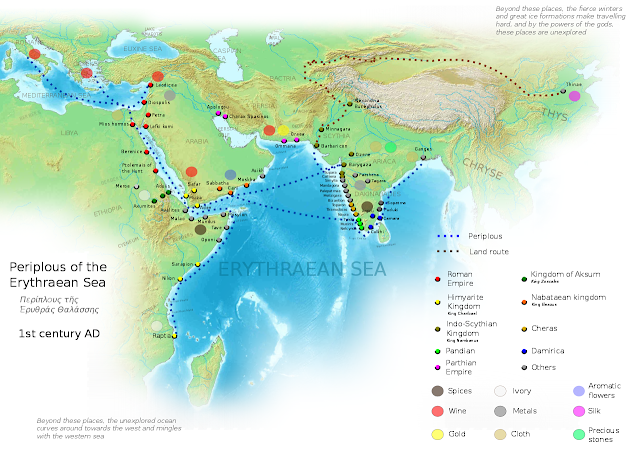The Periplus of the Erythraean Sea, also known by its Latin name as the 'Periplus Maris Erythraei', is a Greco-Roman periplus written in the Koine Greek ( Common Greek) language,which describes navigation and trading opportunities from Roman Egyptian ports like Berenice Troglodytica along the coast of the Red Sea, and others along Horn of Africa, the Sindh region of Pakistan, along with southwestern regions of India. The text has been ascribed to different dates between the 1st and 3rd centuries CE.
The Periplus of the Erythraean Sea primarily focuses on two trade routes originating at Egyptian ports: the first one is on the East African coast as far as Tanzania, and the other via the Arabian peninsula and Persian Gulf to western India. The author writes about numerous cities in detail, ports and harbours on these routes. However, the place which accounts for nearly half the narrative is India’s western coast, from Karachi down to Kanyakumari on the southernmost tip.
The Periplus of the Erythraean Sea, tells us of three vital but overlooked aspects of the ancient Indian Ocean trade.The ports, harbours, and metropolises located on the Indian Ocean coasts and are mentioned in the Periplus may not be well-known today- yet,during that time they were some of the most vibrant trading centres of the world.
The text mentions nearly 20 Indian ports, markets, and towns painting a picture of a buzzing world of trade, production, and social exchange at around 50 CE. Over the centuries that followed, Indian ports, urban, and commercial centres rose to prominence as some of biggest cities of the medieval world.
The Periplus of the Erythraean Sea primarily focuses on two trade routes originating at Egyptian ports: the first one is on the East African coast as far as Tanzania, and the other via the Arabian peninsula and Persian Gulf to western India. The author writes about numerous cities in detail, ports and harbours on these routes. However, the place which accounts for nearly half the narrative is India’s western coast, from Karachi down to Kanyakumari on the southernmost tip.
The Periplus of the Erythraean Sea, tells us of three vital but overlooked aspects of the ancient Indian Ocean trade.The ports, harbours, and metropolises located on the Indian Ocean coasts and are mentioned in the Periplus may not be well-known today- yet,during that time they were some of the most vibrant trading centres of the world.
The text mentions nearly 20 Indian ports, markets, and towns painting a picture of a buzzing world of trade, production, and social exchange at around 50 CE. Over the centuries that followed, Indian ports, urban, and commercial centres rose to prominence as some of biggest cities of the medieval world.
Early Chera, Pandyan, and Chola kingdoms
The Periplus shows how merchants had to deal with restrictive rulers and their officials, face the threat of pirates and negotiate with vendors who drove hard bargains. Trade was conducted through barter as well as with money. Maritime ports were linked, particularly in India, to webs of internal riverine routes and inland trading and production centres.
The lost port city of Muziris (near present-day Cochin) in the Chera kingdom, as well as the Early Pandyan Kingdom are mentioned in the Periplus as major centers of trade, between Damirica and the Roman Empire.The goods included pepper and other spices, metal work and semiprecious stones.
According to the Periplus, numerous Greek seamen managed an intense trade with Muziris:
"Then come Naura (Kannur) and Tyndis, the first markets of Damirica or Limyrike, and then Muziris and Nelcynda, which are now of leading importance. Tyndis is of the Kingdom of Cerobothra; it is a village in plain sight by the sea. Muziris, of the same kingdom, abounds in ships sent there with cargoes from Arabia, and by the Greeks; it is located on a river (River Periyar), distant from Tyndis by river and sea about five hundred stadia, and up the river from the shore twenty stadia. Nelcynda is distant from Muziris by river and sea about five hundred stadia, and is of another Kingdom, the Pandian. This place also is situated on a river, about one hundred and twenty stadia from the sea."
Damirica or Limyrike is Tamilagam (Tamil தமிழகம்) – the "Tamil country". Further, this area served as a hub for trade with the interior, in the Gangetic plain:
The Periplus also describes the annual fair in present-day Northeast India, on the border with Tibet.
"Every year there turns up at the border of Thina a certain tribe, short in body and very flat-faced ... called Sêsatai ... They come with their wives and children bearing great packs resembling mats of green leaves and then remain at some spot on the border between them and those on the Thina side, and they hold a festival for several days, spreading out the mats under them, and then take off for their own homes in the interior."
Indo-Greek kingdom
The Periplus explains that coins of the Indo-Greek king Menander I were current in Barigaza.Also, the text mentions that Greek buildings and wells exist in Barigaza (Bharuch).
The metropolis of this country is Minnagara, from which much cotton cloth is brought down to Barygaza. In these places there remain even to the present time signs of the expedition of Alexander, such as ancient shrines, walls of forts and great wells.
The Periplus further claims to the circulation of Indo-Greek coinage in the region of Barygaza, coming from this country, bearing inscriptions in Greek letters, and the devices of those who reigned after Alexander, Apollodorus and Menander.
Read all the book in English here: Periplus of the Erythraean Sea















No comments:
Post a Comment